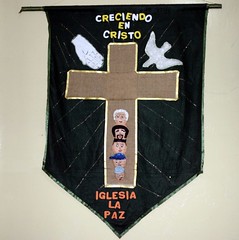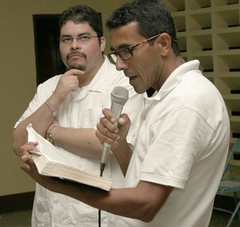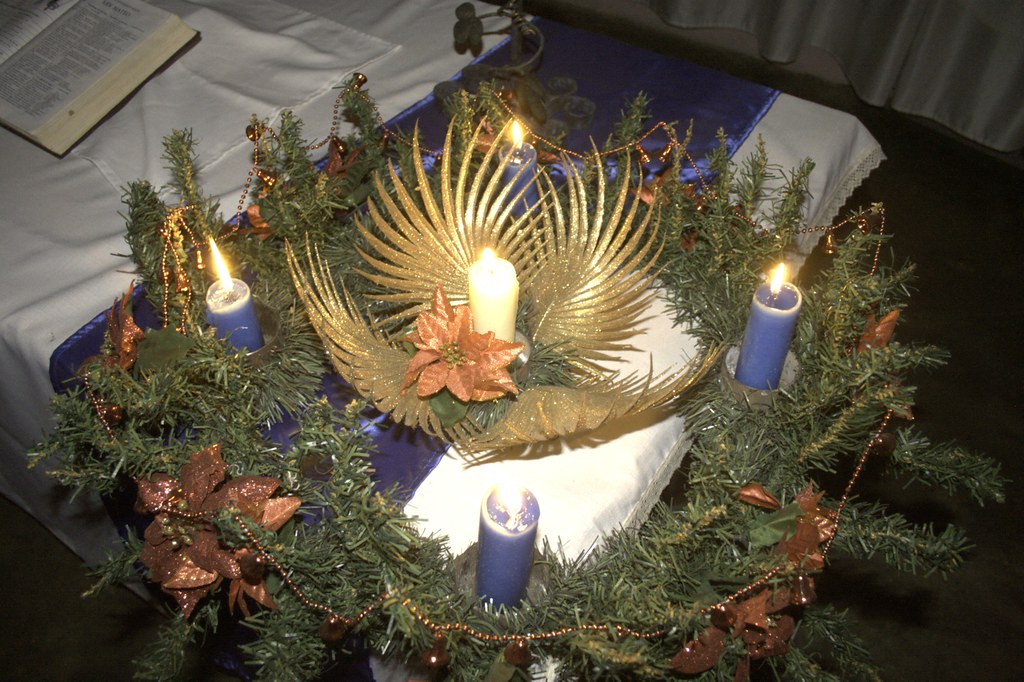
It can terribly distracting when the entire Advent wreath catches on fire during the worship service.
Here is how it happened: Corpus Christi Lutheran Church does not have air-conditioning nor what we North Americans would call “storm windows”. Most of the windows in the church are protected by a wrought-iron framework which includes louvered glass panes which may
be closed in the event of rain. The window nearest the altar, however, only has iron bars to keep out intruders, but no louvered glass.
Often we have trouble keeping the candles on the altar lit when there is a good, stiff breeze blowing. This time, however, the problem was not keeping the candles lit. Rather, the breeze fanned the flames into a close encounter with less-than-fireproof material.
Luckily, there was no serious property damage, although Virginia Jimenez burned her finger helping me put out the fire.

The beautiful Advent wreath, with four blue candles and one white Christmas candle, was made by Ludy de Tarazona, a member of Corpus Christi. We thank God that it served its purpose in marking the weeks of Advent before this unfortunate incident and that it almost certainly can be repaired for continued use. We also give thanks that the Advent season and Christmas Day passed with little incident and the receipt of many gifts, including hallacas (the traditional
Venezuelan Christmas dish) and a bottle of wine from the older fellow who lives at the bottom of our hill.
There were more than 30 people in attendance at Corpus Christi on Christmas Eve. We thank God for this also, for as I have explained before, the idea of attending a midweek service is quite novel for most Venezuelans. The majority spend their Christmas/New Year vacations in the mountains or on the beach, or partying at home with family and friends. We had no December 25 service, so Sunday, December 28, was our Christmas service, more or less. There were about 20 in attendance.
That same Sunday I also led a complete worship service in La Caramuca, with Holy Communion for our confirmed young people. Eduardo Flores said his farewell to Corpus Christi and returned to Caracas after Christmas Eve. Corpus Christi still does not have its own pastor, so this is the plan for now: I will lead the service and distribute Holy Communion every Sunday morning at Corpus Christi and every Sunday afternoon in La Caramuca.
Alonso Franco will arrive in January to serve as vicar at Corpus Christi for three months, thus sharing some of the load. We look forward to seeing Alonso, because he and his parents, Pastor Alcides and Nancy, are old friends of Luz Maria and her children. Luz Maria considered Alcides Franco her mentor in the faith during the years she lived in San Felix de Guayana.
Remembering the Holy Innocents
According to the church calendar, December 28 is always the day dedicated to the Holy Innocents of Bethlehem, the male children that King Herod slaughtered in his rage against the newborn Christ (with whom Joseph and Mary fled to Egypt), and to Christian martyrs around the world. I would recommend the Web site,
www.persecution.net, for learning about the more obvious ways in which Christians are persecuted today and how Christians in many parts of the world do not have the blessing of religious liberty that Christians have in the United States. The Web site is sponsored by “Voice of the Martyrs”, an organization founded by Richard Wurmbrand.
It was about 20 years ago that a friend gave me copies of Wurmbrand's books, “Tortured for Christ” and “In God's Underground”. Born a Romanian Jew, Wurmbrand flirted with Marxism
as a young man, converted to Christianity and eventually was ordained a Lutheran pastor. He was imprisoned for many years by the Romanian Communists. He at last found political asylum in the United States and western Europe.
Of course, this year December 28 also was the first Sunday after Christmas, so although I mentioned persecuted Christians in the general prayer, we used the Scripture lessons appointed for the first Sunday after Advent rather than the Day of the Holy Innocents.
Historic lectionary a help
Starting with this liturgical year, the Lutheran Church of Venezuela has returned to “the
historic one-year lectionary”. The practice of preaching from a text appointed for the day predates the New Testament. When Jesus revealed Himself as the Messiah in the Nazareth synagogue, according to Luke 4:16-21, He preached from Isaiah 61:1-2, the appointed reading for that day. Various other passages in the New Testament indicate that the early Christians continued the practice of Scripture readings as they did much of the rest of Jewish liturgical tradition.
The church calendar developed as a way of rehearsing, through the course of the year, the important events in the life of Christ, especially His birth, passion and resurrection. A common lectionary designed to follow this annual cycle first appeared in 471 A.D. Further standardization of the lectionary occurred 300 years later in western Christendom under the reign of Charlemagne. Finally, by the end of the 13th Century, the lectionary had taken the form
it would retain until 1969.
In that year, the Roman Catholic Church abandoned the one-year lectionary in favor of a three-year cycle of Scriptural lessons. In a fit of ecumenical fervor, Episcopalians, Lutherans, Presbyterians and other Protestant church-bodies followed suit. The reasons given for this change were that:
The three-year cycle would give pastors a wider range of Scripture verses on which to base their sermons, and;
Increase Biblical literacy among the laity.
Ironically, although the one-year lectionary had been used by Catholics and Protestants alike for nearly 400 years, the united front for the three-year lectionary soon began to splinter. Each
denomination began revising it, until each had their own distinct version.
Never mind the Catholics, Anglicans and Presbyterians. The Thrivent pastor's agenda that I was given to use for 2008 has three different
Lutheran versions of the Series “A” readings for each Sunday: one for the Evangelical Lutheran Church in America (ELCA), one for the Lutheran Church – Missouri Synod and one for the Wisconsin Evangelical Lutheran Synod (the Lutheran Church of Venezuela followed the WELS version last year). Personally I found it difficult to just glance at the agenda to make sure I had the right lesson in hand when my eyes had to run down the list of the three versions.
My point being, the three-year lectionary does not make preaching easier for novices like myself. I find the one-year lectionary simpler and more useful. Also, the idea behind a common lectionary never was to “widen options” but to sharpen the focus of preaching throughout the church and discourage pastors from using the Christian pulpit as a soapbox for their personal opinions.
As for increasing Biblical literacy among the laity, a review of research
by George Barna and associates will reveal how unsuccessful the three-year lectionary has been at achieving this goal.
Finally, one great advantage to the one-year lectionary is the rich heritage of hymnody, sermons and other liturgical resources that have been based on it. There is much material from which to draw inspiration, including the sermons of Martin Luther himself. Concordia Publishing House
just released a volume of Luther's sermons translated into Spanish that I purchased through the Juan de Frias Theological Institute for about $8. However, Luz Maria grabbed it and won't let me have it until she is done reading it.
 Workshop on Christian art
Workshop on Christian artLuz Maria has been organizing a workshop on Christian art to be held in Caracas on January 9. The idea came to her after the ordination service in December. As part of our ordination, Eduardo, Sergio and I were presented with red stoles (symbolic of Pentecost, the season of the Holy Spirit) hand-made by Yoxandris Marcano, a young woman from Monagas. Yoxandris also made a beautiful green stole (for the Trinity season on the church calendar) for her boyfriend,
Sergio.
Also, the three pastors from La Reforma Lutheran Church in San Felix de Guayana – Alcides Franco, Jonathan Franco and Luis Moya – wore elegant chasubles made by Luis' wife. The chasuble is a poncho-like garment which, according to the ancient liturgical tradition, is worn over the alb and stole by the presiding pastor during the service of Holy Communion. During the 16
th Century, Lutheran
pastors wore chasubles as a matter of course, but with the rise of Pietism in the late 17
th Century and the continuing influence of Calvinism, many such “high church” accoutrements were abandoned. The anti-liturgical influence was particularly strong in the United States, where the strains of Pietism, Calvinism and Arminianism have formed the basis of popular religion from the nation's beginning. In recent years the chasuble
has been reintroduced in some Lutheran churches in North America and now, apparently in Venezuela.
I should explain that, despite external pressures, Lutherans historically have held to the “normative principle of worship”, which may be summed up as saying that the ancient traditions of the church should be preserved as long as they do not conflict with the doctrines of Holy Scripture. This is opposed to the “regulative principle of worship” held by Calvinists, Arminians and Anabaptists, which says that only practices explicitly commanded in Scripture may be allowed in public worship. Once this principle was taken to the extreme of prohibiting all musical instruments (because none are mentioned in the New Testament) and all hymns other than
metrical versions of the Psalms (in England, the Puritans advocated “the iron rule of psalmody”).
The Westminster Confession states:
"The acceptable way of worshipping the true God is instituted by Himself, and so limited by His own revealed will, that He may not be worshipped according to the imaginations and devices of men, or the suggestions of Satan, under any visible representation, or any other way not prescribed in the Holy Scripture." (WCF 21.1)
Nowadays many churches in the Reformed tradition allow “contemporary Christian music” and “praise bands”, but remain fairly hostile to the use of visual arts which do not require a video screen. In Venezuela, many “evangelical” churches take this to the extreme of not allowing even plain crosses, much less crucifixes (with the image of Christ), set up inside or outside their sanctuaries. The only way you can tell these churches from public auditoriums is the presences of plaques bearing Bible verses on the back walls.
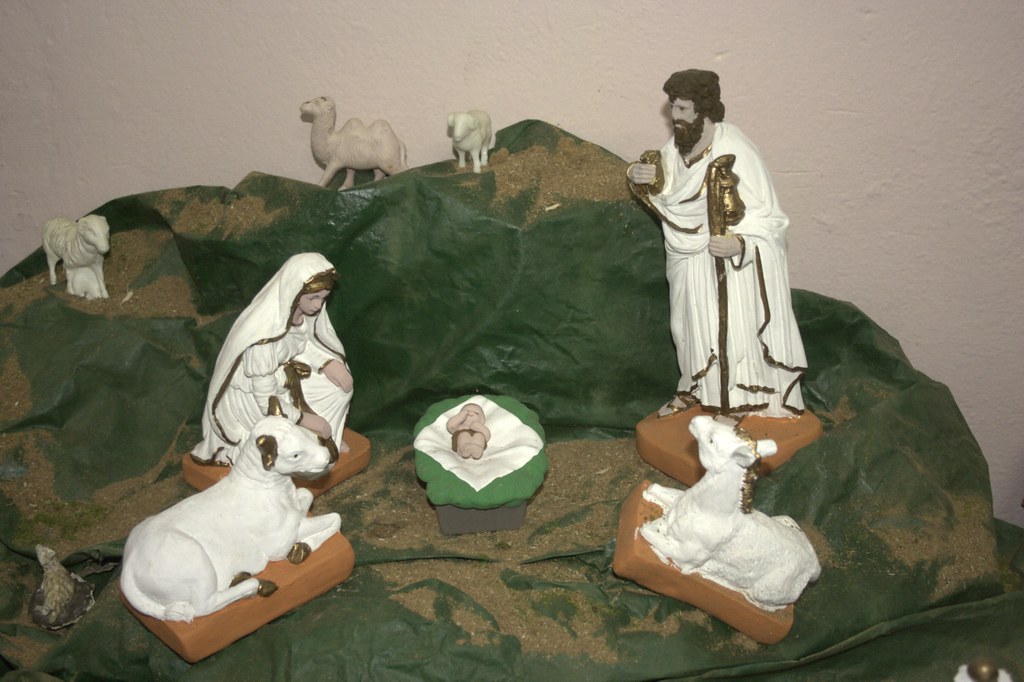
It is for this reason that one of our neighbors in La Caramuca, a staunch Roman Catholic, declared that the spread of Protestantism within the community was destroying traditional Christmas customs (such as the construction of elaborate manger scenes, which Venezuelan evangelicals regard as idolatry).
In contrast, the Lutheran Confessions say:
“Falsely are our churches accused of abolishing the Mass; for the Mass is retained among us, and celebrated with the highest reverence. Nearly all the usual ceremonies are also preserved, save
that the parts sung in Latin are interspersed here and there with German hymns, which have been added to teach the people.” (Augsburg Confession, Article XXIV: Of the Mass)
“At the outset we must again make the preliminary statement that we do not abolish the Mass, but religiously maintain and defend it. For among us masses are celebrated every Lord's Day and on the other festivals, in which the Sacrament is offered to those who wish to use it, after they have been examined and absolved. And the usual public ceremonies are observed, the series of lessons, of prayers, vestments, and other like things.” (Apology of the Augsburg Confession, Article XXIV (XII), Of the Mass)
- “For although the holy Fathers themselves had both rites and traditions, yet they did not hold that these matters are useful or necessary for justification; they did not obscure the glory and office of Christ, but taught that we are justified by faith for Christ's sake, and not for the sake of these human services. But they observed human rites for the sake of bodily advantage, that the people might know at what time they should assemble; that, for the sake of example all things in the churches might be done in order and becomingly; lastly, that the common people might receive a sort of training. For the distinctions of times and the variety of rites are of service in
admonishing the common people. The Fathers had these reasons for maintaining the rites, and for these reasons we also judge it to be right that traditions [good customs] be maintained.” (Apology of the Augsburg Confesson, Article XV (VIII): Of Human Traditions in the Church)
- The Lutheran Reformers realized that certain rites and practices, while not absolutely required by Holy Scripture, were valuable in a number of ways, for example, as visual aids in teaching
the people. Stained-glass windows originally were a way of illustrating Bible stories for a largely illiterate population.And, of course, music and visual arts provide avenues of artistic expressions for believers as signs of their devotion to God.
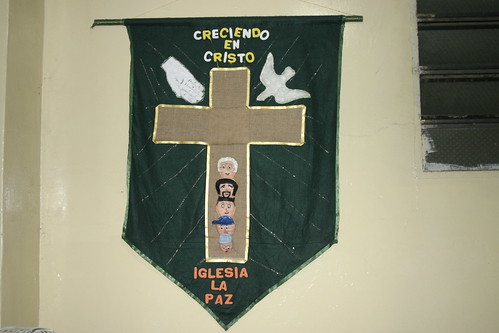 Which is what Luz Maria's workshop will be about. In addition to the examples that I mentioned above, many members of the Lutheran Church of Venezuela have demonstrated their talents in the making of stained glass, baptismal fonts, crosses and crucifixes and in other ways. Luz Maria has been very pleased with the enthusiastic response to the workshop so far.
Which is what Luz Maria's workshop will be about. In addition to the examples that I mentioned above, many members of the Lutheran Church of Venezuela have demonstrated their talents in the making of stained glass, baptismal fonts, crosses and crucifixes and in other ways. Luz Maria has been very pleased with the enthusiastic response to the workshop so far.
- What about Papa Noel?
- During Advent we covered the Nativity story with the Sunday school children. But one boy asked, “What about Papa Noel?” Papa Noel is another name for Santa Claus in Venezuela. The boy was particularly interested because his name is Jefferson Noel, his brother's name is
Noel Alexander, and his sister's name is Genesis Noeli.

- So I told him that Papa Noel was really Nicholas, bishop of the city of Myra, in what is now Turkey, in the fourth century after Christ. Once there was a very poor couple who had three
daughters. It was the custom in those days that the family had to provide a dowry for each daughter to get married. This family did not have any money, so it appeared the girls had no other options in life but to become prostitutes. Nicholas gathered up enough gold coins to
provide each of the three with a dowry, put the money in three bags and in the dead of night threw the bags through a window in the family's home. That is how the legend of Papa Noel, or Santa Claus, got started.
- I did not tell him my favorite part of the real St. Nicholas story: How the bishop of Myra attended the Council of Nicaea as a defender of Trinitarian doctrine against the heresy of Arianism and how he supposedly punched the arch-heretic Arius right in the face!
- With that image of “action hero Santa” in mind, I wish everyone a Merry Christmas and a prosperous New Year.
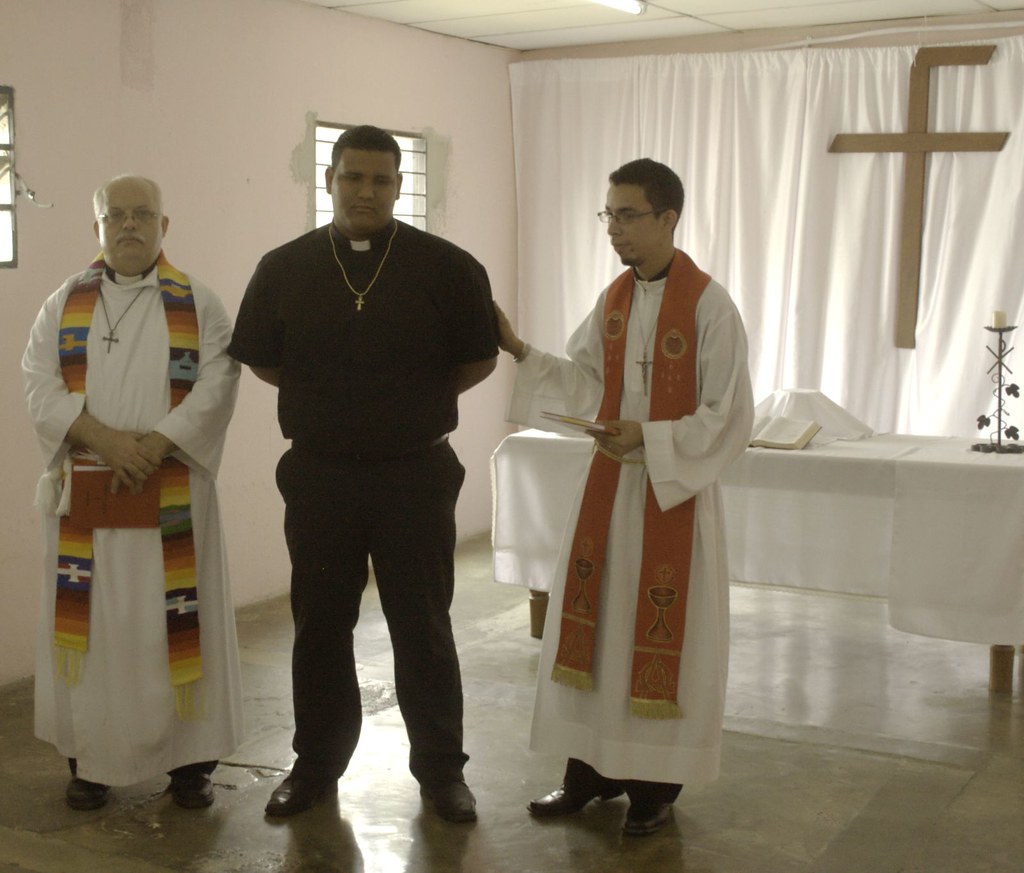
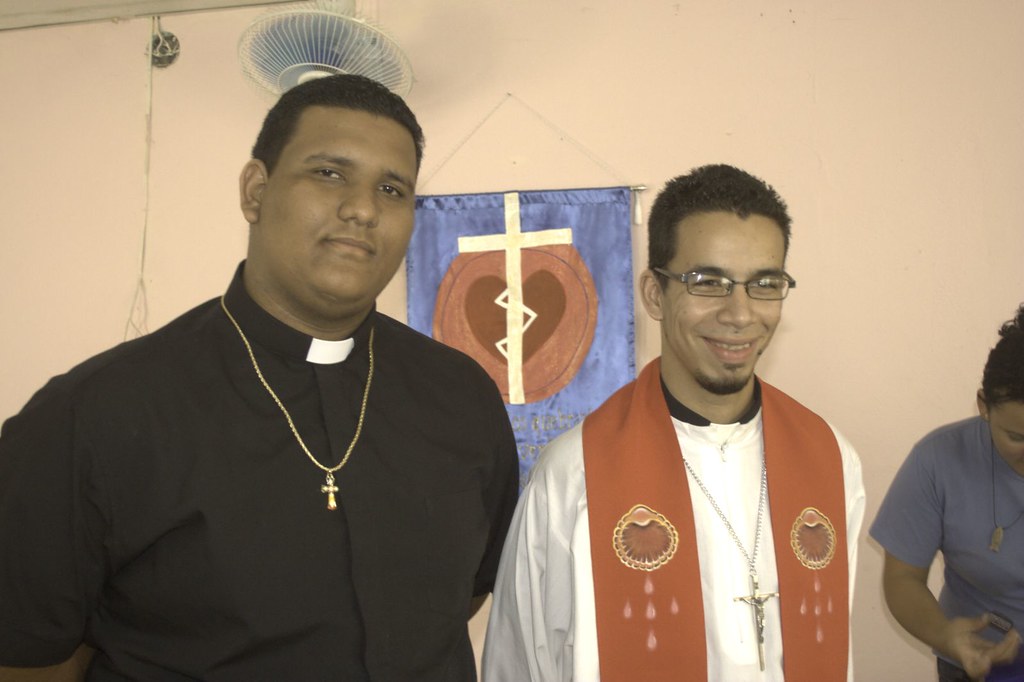




















 He continued studying theology through the Juan de Frias Institute and eventually served as pastor of Principe de Paz (Prince of Peace) Lutheran Church in the small village of Sierra Caroni.
He continued studying theology through the Juan de Frias Institute and eventually served as pastor of Principe de Paz (Prince of Peace) Lutheran Church in the small village of Sierra Caroni.